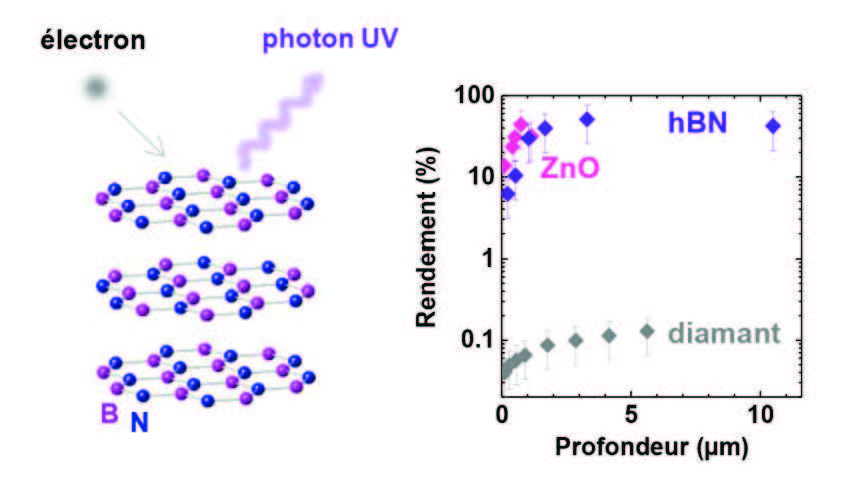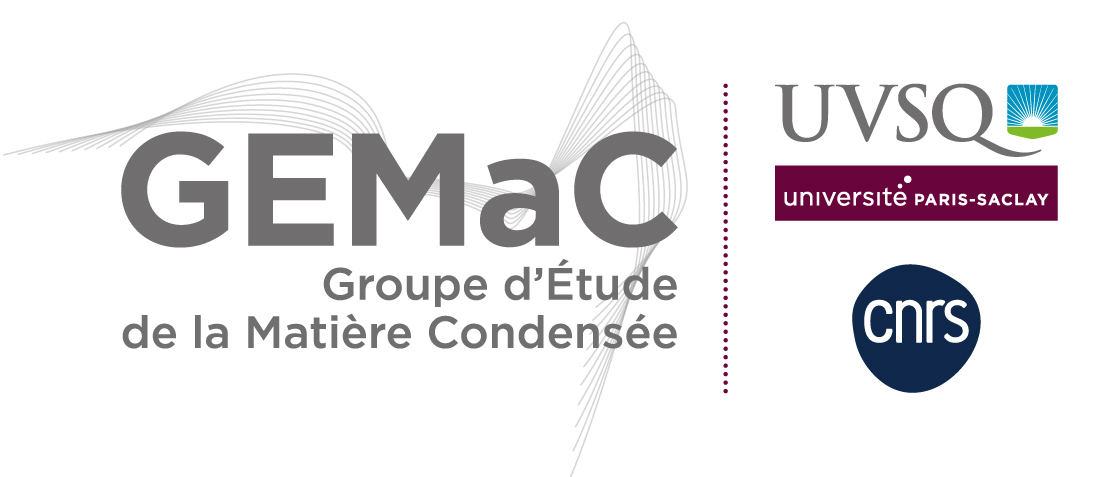You are here : GEMACENHighlights
- Partager cette page :
- PDF version
Hexagonal boron nitride, a crystal with astonishing ultraviolet light
Hexagonal boron nitride (hBN) emits ultraviolet light with an unusually high intensity for an indirect semiconductor. This apparent contradiction was finally explained by the particular nature of the excitons, revealed both by quantitative measurements and by their modelling.
The light emission of semiconductor materials is based on the energy band gap of their electrons. This range of energy values, which they cannot assume, is delimited by the conduction band and the valence band. If the ends of these two bands are aligned on the same wave vector of the electrons, it's a direct semiconductor. If they are offset, it is an indirect semiconductor. The electron-hole pairs, resulting from the excitation of an electron from the valence band to the conduction band, form ephemeral quasi-particles called excitons. In direct semiconductors, these electron-hole pairs have a high chance of emitting photons. They are therefore naturally preferred for the manufacture of light-emitting diodes and lasers. Indirect semiconductors, on the other hand, can only emit a photon if a phonon - which corresponds to an excitation mode of the crystal lattice - is also emitted, which drastically reduces their light output, thereby significantly reducing their application potential. However, hexagonal boron nitride (hBN), an indirect semiconductor with a lamellar structure similar to graphite, challenges these established facts.
Researchers from the Groupe d'étude de la matière condensée (GEMaC, CNRS/Université Versailles Saint-Quentin-en-Yvelines), the Laboratoire d'étude des microstructures (LEM, CNRS/ONERA) and the National Institute for Materials Science (NIMS) in Tsukuba, Japan, have shown that in spite of its indirect band gap, hBN emits photons almost systematically and very reliably with an efficiency of almost 100% at the ultraviolet wavelengths. This efficiency has been measured by cathodoluminescence, a technique that measures the emission of light that follows an electron beam bombardment. Theoretical calculations and numerical simulations carried out by the researchers showed that this behaviour was due to the unusual properties of the excitons. These are characterized by the very high energy that binds the electrons to the holes (300 meV). Moreover, these calculations also made it possible to establish how, in hBN, the direct or indirect nature of the excitons makes it possible to elucidate the differences observed between the photons involved in luminescence and absorption, a very unusual case that was the subject of debate. This work could help in the development of optoelectronics, graphene and 2D materials. Indeed, hBN represents an excellent substrate and encapsulant for graphene. Its brilliance could also be exploited as a compact UV source, for example to purify water.

Lamellar crystals of hexagonal boron nitride emit in the ultraviolet when excited by an electron beam. Measurements show that their internal quantum efficiency is close to 100%, despite an indirect type band gap. Zinc oxide (direct) and diamond (indirect) are shown in comparison.
For further information, read:
"Bright luminescence from indirect and strongly bound excitons in hBN"
Physical Review Letters 122 (2019) 067401 – [HAL] – [arXiv]
Contact
Julien Barjon, enseignant-chercheur au GEMaC
Annick Loiseau, directrice de recherche Onera au LEM
Link for INP publication
Researchers from the Groupe d'étude de la matière condensée (GEMaC, CNRS/Université Versailles Saint-Quentin-en-Yvelines), the Laboratoire d'étude des microstructures (LEM, CNRS/ONERA) and the National Institute for Materials Science (NIMS) in Tsukuba, Japan, have shown that in spite of its indirect band gap, hBN emits photons almost systematically and very reliably with an efficiency of almost 100% at the ultraviolet wavelengths. This efficiency has been measured by cathodoluminescence, a technique that measures the emission of light that follows an electron beam bombardment. Theoretical calculations and numerical simulations carried out by the researchers showed that this behaviour was due to the unusual properties of the excitons. These are characterized by the very high energy that binds the electrons to the holes (300 meV). Moreover, these calculations also made it possible to establish how, in hBN, the direct or indirect nature of the excitons makes it possible to elucidate the differences observed between the photons involved in luminescence and absorption, a very unusual case that was the subject of debate. This work could help in the development of optoelectronics, graphene and 2D materials. Indeed, hBN represents an excellent substrate and encapsulant for graphene. Its brilliance could also be exploited as a compact UV source, for example to purify water.

Lamellar crystals of hexagonal boron nitride emit in the ultraviolet when excited by an electron beam. Measurements show that their internal quantum efficiency is close to 100%, despite an indirect type band gap. Zinc oxide (direct) and diamond (indirect) are shown in comparison.
For further information, read:
L. Schué, L. Sponza, A. Plaud, H. Bensalah, K.Watanabe, T. Taniguchi, F. Ducastelle, A. Loiseau, J. Barjon
Physical Review Letters 122 (2019) 067401 – [HAL] – [arXiv]
Contact
Julien Barjon, enseignant-chercheur au GEMaC
Annick Loiseau, directrice de recherche Onera au LEM
Link for INP publication





